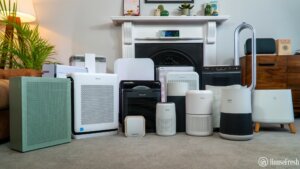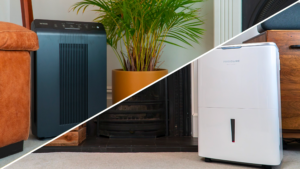PlasmaWave is a relatively recent air purification technology pioneered by the South Korean company Winix. The company claims this process produces much cleaner, healthier air by removing harmful particulates.
Concerns around COVID-19 have boosted the popularity of this product and others like it in recent years, with its sales spreading internationally.
This article will discuss what PlasmaWave is, how it works and whether it’s effective. We’ll dissect the potential hazards of the technology, explore whether the benefits outweigh the risks and ultimately decide whether this new technique is a net positive for air purification!
PlasmaWave explained
Alongside traditional filters (such as HEPA and activated charcoal filters), PlasmaWave technology is the core purification method of Winix purifiers. The technology behind PlasmaWave is a type of ionization, an air purification method already in use by many products.
PlasmaWave uses bipolar or needlepoint ionization — a complicated process, but we’ll provide a simplified version of how it works.
Bipolar ionization begins by creating a high-voltage electrical current. When exposed to the air, this current reacts with water vapor to form charged particles called ions. When hit by this high voltage, the H2O particles split into their charged components, becoming O2- (negatively charged oxygen) and H+ (positively charged hydrogen). This charge is caused by the particle losing or gaining an electron.
These charged particles will then attract those of opposite charge, recombining into OH. This is a reactive hydroxyl radical — effectively an “unbalanced” particle that needs another hydrogen atom to “rebalance”. The OH particle will then seek to pull hydrogen from other molecules to fill this space.
Doing so will remove the structurally crucial hydrogen from viruses, bacteria, volatile organic compounds (VOCs) and mold spores— rendering them uninfectious or even eradicating them.
Once hydrogen is taken from the other particle, the hydroxyls will return to ordinary H2O vapor.This process purifies these harmful particulates and gasses from the air.
In comparison, unipolar ionization creates only negatively charged particles. These are attracted to the unwanted positive particles, sticking to them. This causes the now-heavier particles to drift onto surfaces, allowing them to be wiped, swept, or vacuumed away.
If left for too long, the particles may lose their charge and be released back into the air.
Is PlasmaWave safe?
The effectiveness and safety of ionization as a method of air purification is hotly-debated, with plenty of conflicting opinions available. Unipolar ionization has been largely dismissed as unnecessary and potentially harmful for several reasons.
While it reduces levels of some VOCs, negative ions have been found to create harmful byproducts over time. Most notably, these are ozone, formaldehyde, acetone and ethanol in oxygenated (airborne) forms.
These negatively impact health in significant ways when present in large amounts. They can cause afflictions such as lung or heart damage, nonfatal heart attacks, irregular heartbeat, aggravated asthma, irritation of the airway, coughing and difficulty breathing.
The most concerning byproduct of this method is ultrafine particles (PM2.5), which can end up deep in the lungs and bloodstream.
The U.S. Environmental Protection Agency (EPA) has also noted that negative ionizers can be fairly ineffective at removing pollen, house dust, odors and harmful gasses from the air.
Additionally, unipolar ionization requires human intervention to wipe away the heavy particles landing on surfaces. If this isn’t done regularly, the method is pretty redundant.
In contrast, bipolar ionization has shown evidence of better results in both effectiveness and safety. When both negative and positive particles are produced by bipolar ionization and hydroxyls are formed, the harmful particulates are actively destroyed or disabled.
Once this is complete, the hydroxyls return to a state of water vapor. This means that less harmful byproducts are created (though some still are).
Bipolar ionization has also been found to be more effective at removing microscopic particles untouched by traditional ionization methods, including viruses like COVID-19.
It should be noted that ozone is still a byproduct of this process and the amount produced will vary greatly between each device. Winix products claim to produce only 3 ppb (parts per billion) of ozone.
Additionally, Winix devices meet the California Air Resource Boards AB 2276 standard for safety. Many of their devices also allow the PlasmaWave function to be turned off.
Final thoughts
Unfortunately, solid research on ionizers— especially bipolar ones — is lacking. It’s hard to determine whether these products are effective or what dangers they may pose through long-term exposure. It should also be noted that traditional, filter-based air purifiers are much more well-researched.
They have been proven highly effective at removing harmful particulates from the air, with minimal safety concerns. It may be better to stick with classic filtration methods when trying to clean the air in your home.
HEPA and activated charcoal filters effectively clean harmful particulates from the air. At this time, there aren’t any apparent benefits of using ionization methods over classic air purification.
SOURCES
- EurekAlert. (2021). Study Uncovers Safety Concerns With Some Air Purifiers. eurekalert.org
- Bryan, R. (2023). What is Winix PlasmaWave? ausclimate.com.au
- Iso-Aire. (2023). What Is Bipolar Ionization and How Does It Work? iso-aire.com
- United States Environmental Protection Agency. (2023). Can Air Cleaning Devices That Use Bipolar Ionization, Including Portable Air Cleaners And In-Duct Air Cleaners Used In Hvac Systems, Protect Me From Covid-19? epa.gov
- Well Air Solutions. (2023). How Bipolar Ionization Works. wellairsolutions.com






